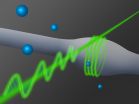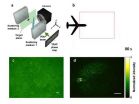Sediment supply drives floodplain evolution in Amazon Basin
2014-11-02
(Press-News.org) A new study of the Amazon River basin shows lowland rivers that carry large volumes of sediment meander more across floodplains and create more oxbow lakes than rivers that carry less sediment.
The findings have implication for the Amazonian river system, which may be significantly altered by proposed mega-dams that would disrupt sediment supplies.
Researchers from Cardiff University's School of Earth and Ocean Sciences examined 20 reaches within the Amazon Basin from Landsat imagery spanning nearly 20 years (1985 to 2013).
They found rivers transporting larger amounts of sediment migrated more, and noted that channel movement did not depend on either the slope of the channel or the river discharge.
The research gives scientists insight into the contrasting behavioural properties of rivers where sediment is an imposed variable – e.g. resulting from glacial, volcanic, or human activity – and rivers were the main sediment supply is from local bank erosion.
Dr José Constantine, Lecturer in Earth Sciences at Cardiff University's School of Earth & Ocean Sciences and lead author of the paper said: "We found that the speed at which the meanders migrated for each of the rivers studied depended on the river's supply of sand and silt. The meanders of rivers carrying more sediment migrated faster than those carrying less sediment, and were also more frequently cut off and abandoned to form U-shaped lakes. If sediment loads are reduced — by a dam, for example — meander migration is expected to slow, and thus the reshaping of the floodplain environment is affected."INFORMATION:
Notes to Editors
The paper, 'Sediment supply as a driver of river meandering and floodplain evolution in the Amazon Basin', will be published on Nature Geoscience's website on Sunday 02 November at 1800 London time at: http://dx.doi.org/10.1038/ngeo2282
The full letter to Nature Geoscience is attached, together with an image showing the sinuosity of reaches studied in the Amazon Basin.
Academic contacts
Dr Jose Constantine, Lecturer in Earth Sciences, School of Earth & Ocean Sciences, Cardiff University: Tel: +44 (0)29 208 70642 mobile +44 (0)7508 046740; ConstantineJA@cardiff.ac.uk
Dr Eli Lazarus, Lecturer in Earth Sciences, School of Earth & Ocean Sciences, Cardiff University: Tel: +44 (0)29 208 75563 ; mobile: +44 (0)7580 330 792; LazarusED@cf.ac.uk @envidynxlab
Media contact
Heath Jeffries, Communications Manager, Cardiff University: +44 (0)2920 870917; mobile +44 (0) 7908 824029; jeffrieshv1@cardiff.ac.uk
ELSE PRESS RELEASES FROM THIS DATE:
Study: 'Wimpy' antibody protects against kidney disease in mice
2014-11-02
CINCINNATI—An antibody abundant in mice and previously thought to offer poor assistance in fighting against infection may actually play a key role in keeping immune responses in check and preventing more serious self-inflicted forms of kidney disease, researchers say.
Led by researchers at the University of Cincinnati (UC) and Cincinnati Children's Hospital Medical Center and published online Nov. 2, 2014, in the journal Nature, the study finds that the mouse antibody IgG1, which is made in large quantities and resembles a human antibody known as IgG4, may actually ...
Two photons strongly coupled by glass fiber
2014-11-02
Two photons in free space do not interact. Light waves can pass through each other without having any influence on each other at all. For many applications in quantum technology, however, interaction between photons is crucial. It is an indispensable prerequisite for transmitting information through tap-proof quantum channels or for building optical logic gates. At the Vienna University of Technology (TU Wien), scientists have now succeeded in establishing a strong interaction between two single photons. This opens up completely new possibilities for quantum optics. The ...
Improving imaging of cancerous tissues by reversing time
2014-11-02
As a child, it was fascinating to put a flashlight up to our palms to see the light shine through the hand. Washington University in St. Louis engineers are using a similar idea to track movement inside the body's tissues to improve imaging of cancerous tissues and to develop potential treatments.
Lihong Wang, PhD, the Gene K. Beare Distinguished Professor of Biomedical Engineering at the School of Engineering & Applied Science is applying a novel time-reversal technology that allows researchers to better focus light in tissue, such as muscles and organs.
Current ...
Mutant models
2014-11-02
Nate Silver and Richard Feynman walk into a bar and bump into a biologist . . .
While this may sound like the setup to some late-night nerd sketch, researchers have taken this premise and applied it to an increasingly cumbersome problem in modern biology, namely, finding meaning in the rising oceans of genomic data.
In this specific instance, the data comprisesreams of cancer mutations that genome-wide studies are publishing at a dizzying rate. The challenge is finding new and efficient ways to parse the signal from the noise (and there is no shortage of noise).
As ...
Ultracold disappearing act
2014-11-02
A disappearing act was the last thing Rice University physicist Randy Hulet expected to see in his ultracold atomic experiments, but that is what he and his students produced by colliding pairs of Bose Einstein condensates (BECs) that were prepared in special states called solitons.
Hulet's team documented the strange phenomenon in a new study published online this week in the journal Nature Physics.
BECs are clumps of a few hundred thousand lithium atoms that are cooled to within one-millionth of a degree above absolute zero, a temperature so cold that the atoms march ...
New technique efficiently turns antibodies into highly tuned 'nanobodies'
2014-11-02
Antibodies, in charge of recognizing and homing in on molecular targets, are among the most useful tools in biology and medicine. Nanobodies – antibodies' tiny cousins – can do the same tasks, for example marking molecules for research or flagging diseased cells for destruction. But, thanks to their comparative simplicity nanobodies offer the tantalizing prospect of being much easier to produce.
Unfortunately, their promise hasn't been fully realized, because scientists have lacked an efficient way of identifying the nanobodies most closely tuned to their ...
'Invisible tattoos' could improve body confidence after breast cancer radiotherapy
2014-11-02
Invisible tattoos could replace the permanent dark ink tattoos used to ensure that breast cancer patients having radiotherapy are treated in exactly the same spot during each session, according to results from a pilot study to be presented at the National Cancer Research Institute (NCRI) Cancer Conference today (Sunday)*.
Research suggests that the permanent pin prick marks made on the skin of women having radiotherapy reminds them of their diagnosis for years to come, reducing body confidence and self-esteem.
It's also more difficult to spot these tattoos in dark-skinned ...
Step towards blood test for many cancer types
2014-11-02
Scientists have identified more than 800 markers in the blood of cancer patients that could help lead to a single blood test for early detection of many types of cancer in future, according to research presented at the National Cancer Research Institute (NCRI) Cancer Conference in Liverpool today (Sunday).
This is the first time that cancer-specific blood markers have been comprehensively reviewed and identified for further clinical development. This study, by the UK Early Cancer Detection Consortium*, funded by Cancer Research UK, has analysed 19,000 scientific papers ...
JNS: Pediatrics publishes guidelines for the treatment of pediatric hydrocephalus
2014-11-01
Charlottesville, VA (November 1, 2014). The Journal of Neurosurgery Publishing Group is pleased to announce today's publication of "Pediatric hydrocephalus: systematic literature review and evidence-based guidelines," a supplement to the November issue of the Journal of Neurosurgery: Pediatrics. Authored by a volunteer task force from the pediatric neurosurgery community, the supplement offers a thorough evaluation of the current treatments for pediatric hydrocephalus as well as up-to-date evidence-based recommendations for their use.
Hydrocephalus is a condition in which ...
More penalties on the way for hospitals that treat the poor? New U-M study suggests so
2014-11-01
ANN ARBOR, Mich. – Last week, the federal government revealed that it will fine more than 2,600 hospitals in the coming year, because too many Medicare patients treated at these hospitals are ending up back in the hospital within 30 days of going home. Two new conditions have been added in this round of penalties: elective hip and knee replacement and chronic lung disease.
Now, a new University of Michigan analysis shows that penalties for chronic lung disease will have a greater impact on hospitals that care for poor and minority patients. The findings are published ...


